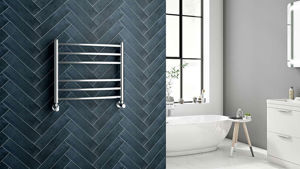A bathroom sink can be a fantastic finishing touch to a bathroom design and should be cared for accordingly. A common downside to bathroom basins is that, due to the nature of their manufacture and material, they can be very easy to damage.
One mistakenly dropped jar of hand cream can quickly leave you with an unsightly mark or chip. But fear not, a chip in a ceramic basin can be easily repaired, given the correct materials and a bit of your time.
Here’s a handy guide to repairing chips or scratches in your sink and it should only take around 30 minutes or so to complete:
So to start, you will need the following:
• Epoxy resin repair kit
• Small brush
• Denatured alcohol
• Disposable cloth
• Single ended razorblade
• 400-grit sandpaper
1. Clean the sink and prepare the surface
Start by cleaning the sink as much as possible to create a clean and smooth work surface. This will ensure that there is no built up soap residue or grime that will ruin the final finish of your chip repair. After you have left the sink to dry, use a small piece of sandpaper to sand away at the damaged area. Be careful not to sand the in-tact parts of the basin around the chip whilst doing this. After sanding, re-clean the affected sink section with denatured alcohol and a clean cloth and leave to dry.
2.Start to apply the sink repair kit
Ceramic sink repair kits are readily available from all major DIY manufacturers around the country. Sometimes, your sink manufacturer may hold stock of repair kits to directly match the finish of your basin so the first thing to do would be to contact them directly beforehand. After you’ve prepped the surface of the sink, start to apply the filler into the basin cracks or chips. To get a smoother finish, use the edge of a razorblade to smooth across the gaps. Only apply a small amount at a time and leave to dry after each coating.
3. Smoothen out the cracks
Once you’ve filled the chip or crack all the way to the surface of the sink, there’s a good chance that it might not look as neat as you would like it. Carefully sand away any excess filler from the sink by using a small piece of sandpaper and a light swirling motion. Make sure you do not scratch the surrounding surface of the sink when doing so.
4. Apply the glaze
Once the filler has been tidied up and sanded correctly, you can start to apply the glaze coating. Apply this in small layers using the brush that is provided within the kit and allow to dry each time. You should try and avoid using too much glaze as it can build up quickly and ruin the final finish if applied too heavily. Once finished, tidy up the glaze if necessary with some sandpaper and a light swirling motion. Once finished, your sink repair should be complete. It may not be a perfect and seamless finish but the chances are that it will be a lot less noticeable than it previously was.
Once the filler has been tidied up and sanded correctly, you can start to apply the glaze coating. Apply this in small layers using the brush that is provided within the kit and allow to dry each time. You should try and avoid using too much glaze as it can build up quickly and ruin the final finish if applied too heavily. Once finished, tidy up the glaze if necessary with some sandpaper and a light swirling motion. Once finished, your sink repair should be complete. It may not be a perfect and seamless finish but the chances are that it will be a lot less noticeable than it previously was.






